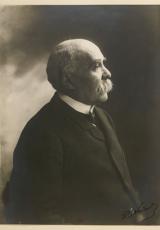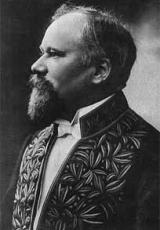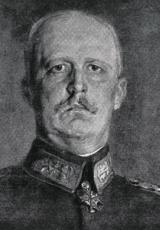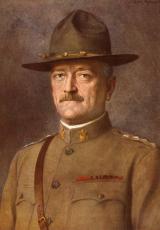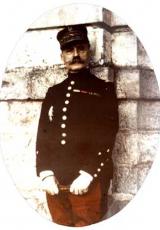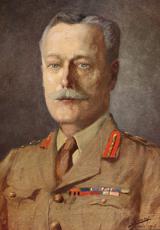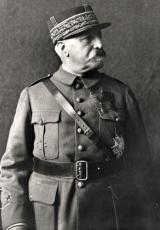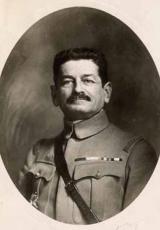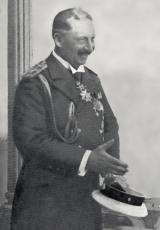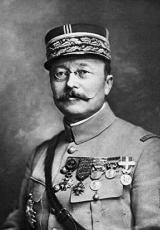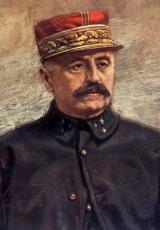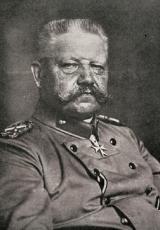1918 - Les temps forts d'une année de combat

Corps 1
Fighting the war: operations With the arrival of The United States, China and Brazil etc. 1917 was to see the conflict escalate to the global level. However, on both sides, any success that was to come was never decisive. And on the eve of the winter of 1917-1918, although the desire to win remained as strong as ever, the warring factions were under no illusions as to how long the conflict would last. Following a spring full of uncertainties, the summer months would see the hopes of Germany and her allies in ruins. The eve of battle In France, Clemenceau's arrival as the government's Minister of War revived energies. But the stability of the commanders and the calmness in the army following the mutiny crisis of the spring of 1917, could barely hide the problem of strength on the ground.
Corps 2
Clemenceau: I will fight the war Recalled by President Poincaré on 16 November 1917 to succeed to Painlevé's cabinet, at 77 years of age, Georges Clemenceau was the man for the situation. "My aim," he said to the Chambers, "is to be the victor." The indomitable energy and remorseless iron will in the face of the task in hand that had given him the nickname the "Tiger", spoke for themselves and could bear this out. The problem with strength on the ground The Russian defection (the Brest-Litovsk armistice of 15 November 1917) soon raised the question of German superiority on the Western Front. The general reserves were to be regrouped and it wouldn't be long before American support came into play. In response to German losses on the Eastern Front (10 divisions per month) in March, Ludendorff, who had left a million men in Russia (54 divisions), transferred 40 divisions to the West. Pétain was concerned and rightly so. Since 1916, the French forces had been in decline.
In 1917, the divisions were reduced from 4 to 3 regiments. The 19th contingent, created in April, provided only 180,000 men, barely reinforced by the 110,000 "recovered" from reserved occupations, unfortunately mostly specialist factory workers. The call was put out to Africa, 80,000 men, and to 100,000 Italian workers; a corps of Czech volunteers was created, plus one made up of Poles. In total, France assembled 109 divisions of which 67 were lined up along a 500 kilometre front that Pétain wanted to see reduced by the English, who, with 58 divisions, 3 of which were cavalry, held 158 kilometres. With a Portuguese division and American units under instruction, we could assemble 172 divisions. Opposite, 192 divisions (36,000 officers, 3,500,000 men). However, equipment was never brought into question; the war machine was turning and even managed to supply the Americans who landed almost all their heavy artillery. Then, in July 1918, on the Western Front, the position completely reversed. The allies had 195 divisions (103 French, 60 British, 12 Belgian, 18 American et 2 Italian).
The strategic problem The allied generals disagreed on a joint strategy in case of German attack. The Englishman Haig was preoccupied with defending the Channel ports; Pétain was worried about covering Paris and not losing troops in the front lines, preferring to contain the assault in the second, or even third lines, (which Clemenceau would refuse at first: we are not giving up one inch of national territory); Foch favoured an offensive approach in the Somme and in the North. In fact Pétain wanted above all to build up great reserves, keeping a pre-eminent role in the alliance for the French army. The hard-nosed Pershing adopted a strategy of concentrating forces on the Western front and refused the amalgamation of his units into the French divisions. On the other side, Ludendorff did not want to wait for American reinforcements to become operational and believed that his troops were just waiting for the right moment to start attacking once more.
Ludendorff's short lived victory Ludendorff prepared 56 divisions specially. He envisaged launching a series of surprise attacks, to be carried out as soon as the breakthrough was made, starting with cutting the front in two, separating the French and the English. The thorns on the Picardy roses: the Northern and Flanders Assaults The first "blow" fell in Picardy, between Arras and La Fère. At 9.40 am on 21 March 1918 along the 80 kilometre front, the infantry set off, supported by 6,200 cannons, limiting preparation time to just 3 hours (surprise effect). The 3rd British Army resisted, but the 5th yielded, as did the 22nd and 23rd. Ludendorff took advantage of his success by pushing his attack onwards to Amiens. There was danger of a gap opening up between the French and the English. On the 24th, the Germans advanced 20 kilometres.
In face of the danger and the risk of Haig becoming surrounded and concerned about saving their coastal bases, Government and army leaders met in Compiègne on the 25th, then at Doullens on the 26th, where the need for a single commander was established. Foch, Chief of the General Staff of the French Armies, responsible for "co-ordinating the action of all allied armies on the Western Front", saw his powers extend to strategic management, military operations and, on the 14th April, he was named Commander in Chief of the allied armies in France. On the 28th March, Pershing offered his available divisions: at the beginning of April, despite the German advance of 60 kilometres, the assault ran out of steam. But on the 6th April, stopped short of Amiens, the German onslaught took up again against the British left wing that Ludendorff wanted to push back towards the coast.
The Battle of Flanders It was to be short but violent. On the 9 April, 21 German shock divisions attacked on the general Lille-Hazebrouck axis. Pétain had 6 divisions brought up as reinforcement and, starting on 15 April, the matter was to be brought to a close when, following fierce battles between the 2nd and 29th April around Mount Kemmel and the Mounts of Flanders, operations came to a standstill and ceased at the end of the month.
It was a strong warning: a German advance of 15 kilometres. The English army was tested and almost all its divisions engaged (55 out of 60): it had lost 300,000 men. The French had engaged 41 divisions and lost 92,000 men. In Paris, anxiety, aggravated by bombardment by long-range weapons ("Bertha") led to the flight of thousands of people. But Ludendorff had considerably eaten into his reserves: he was down 12,000 officers and 326,000 active men. His efforts having been hampered by the intervention of French reinforcements; he was forced to spend time eliminating the French battle corps before pursuing his attempt to destroy the English forces.
The Battle of the Chemin des Dames Between Oise and Reims the Germans took Foch, who was expecting a resumption of operations in the Nord department, by surprise. On 27 May, Ludendorff launched 20 divisions, supported by 3,500 cannons along a 55 kilometre front. These were the 11 divisions of the 6th Army (Duchêne), some of which were depleted, which had been in battle on this quiet front since the previous winter. Same tactics as in Picardy: short preparation of artillery and an overwhelming surge of assault troops. Launched at 1 O'clock in the morning, the attack started very quickly and at 8.30 am the Germans were across the Vesle river and, by the 31 May had reached the Marne. The front was breached; the enemy was 60 kilometres from Paris, where the rumble of cannons could already be heard.
Ludendorff had to dig deep; on the 28th, he took Soissons; to his left, Reims was shelled but Micheler refused to evacuate the town. Confusion reigned. Pétain, anxious for Paris, looked to withdraw the group of Eastern armies (Castelnau) in order to release a body of manpower to cover Paris. Days were bleaker than during the retreat of 1914. But Ludendorff, following the battle close at hand and pushing his reserves into the void he found before him, was surprised by the speed of the advance and feared over-stretching his rear defences and supply problems. To widen the breach and fully take advantage of a success that he had not expected to be so clear-cut, he redirected his 7th and 1st armies towards the south east, towards Compiègne and Epernay.
Foch kept his cool, making his 10th army (4 divisions) available to Pétain. On 31 May, in the presence of Clemenceau, he convinced Pétain and Duchêne to attack. In this way, Pétain was able to square up with 31 divisions. Clemenceau fully supported the military chiefs and on 4 June in the Chamber he responded vigorously to the criticisms directed at them. In fact, the enemy attack was held back; but on 9 June, Ludendorff started the second part of his Chemin des Dames offensive, between Montdidier and Noyon. Hutier's 18 divisions ran up against Mangin's counter-offensive, blocking the German advance on the western flank of the pocket. On 15 June, calm was restored but the enemy, as Clemenceau repeated incessantly, was at Noyon; the reserves were exhausted. Losses for the French army reached 3,400 officers and 136,000 men and the country's confidence was shaken. It was also true that the sudden action did not lack energy, that the American units, engaged at Cantigny (in the Somme) on 28 May and at Bois Belleau (in Marne) on 6 June, had put up a good fight and that the enemy, who had used up 40 divisions, was exposed on the edges of the Soissons-Château-Thierry-Reims pocket, where its supplies were hampered by artillery fire. This led Ludendorff to try to reduce the Reims salient in order to have use of - with Soissons - a second railway intersection and to put the French totally out of the running, before turning back on the English in the North.
The Champagne offensive This assault, the "Friedensturm", the storm of peace, in the presence of Guillaume II, claimed to be decisive. It was to be the ultimate map: in Italy, the Austro-Hungarians had failed to relieve the Western Front and in Palestine the Turks had yielded to the English. But the Germans needed a month to prepare their plan; Foch took advantage of this to rebuild reserves and Pétain, aware of the imminent attack, made sure to leave just a thin veil of troops in the front line. The German assault on 15 July, launched over 90 kilometres, shelled holding positions just before the attack, and broke through to the second line of defence. Had Dormans to the west of Reims been taken and Marne to the east of the salient towards Châlons-sur-Marne been reached, the offensive would not have started. This partial success was to be short-lived. Ludendorff would now lose the initiative.
The march to victory The surprise attack on 18 July Amassed in the forest of Villers-Cotterêts, on the western edge of the pocket were the 10th army (Mangin), 6th army (Degoutte) and an American corps; in total 16 divisions, of which 3 were American infantry divisions. At 4.35 am on 18 July they set off in force, without any artillery preparation, but preceded by a rolling barrage of 2,500 pieces and supported by 800 planes and 350 tanks. On this sunny morning in July where long wisps of fog still floated over the land, assault waves advanced through the already high wheat fields.
The 10th army broke through the same evening, advanced 8 kilometres and captured 10,000 prisoners. Ludendorff was forced to retreat to the Aisne. The victory was important. Tactically, the 27 May pocket was retaken; 28,000 prisoners, 612 cannons and 3,300 machine guns were taken. Strategically, Ludendorff had to abandon his attack on the English in Flanders. The result on morale was huge: "You have given France a sense of victory; you are worthy of your Homeland"; General Mangin was to tell his troops. 8 August 1918 "Day of mourning for the German army" That was Ludendorff's expression. When, on 7 August, Foch was promoted to the esteemed position of Marshal of France, the battle had turned in favour of the allies. On 8 August in Picardy, exactly where Ludendorff had been counting on applying his coup de grâce, it was the Franco-English taking the initiative. The deterioration of the situation was so rapid that on the 13 August, the German Major General anxiously asked the Chancellor to start peace negotiations. In September, when, under constant battering by the Allies, Ludendorff ordered a general retreat to the west, the Eastern and Balkan fronts of the Triple Alliance collapsed.
The beginning of the end In Macedonia, a blistering offensive launched by Franchet d'Esperey broke through between Vardar and Cerna, reaching as far as Uskub, where colonials in Tranié's task force and Jouinot Gambetta's cavaliers were surging towards the enemy's rear lines in a march of epic proportions. In Bulgaria on 29 September the armistice was signed and the 11th German army capitulated: 80,000 men, 1,600 officers and 500 cannons. The road to Vienna was open; the Serbs were over the Danube. In Palestine and Syria, Ottoman troops disintegrated under English fire and on 30 October, Turkey surrendered under the Mudros Armistice. The Franco-English fleet entered the Bosphorus.
The final assault At the end of August, Foch decided to carry out a general offensive. After the attack of 8 August, those of 17 and 18 August in the northern Somme and to the east of Oise, of the 26th for the British in Artois, led the Allies to the Hindenburg line. Péronne and Noyon were reached. Between 12 and 15 September, General Pershing's 1st American army successfully reduced the Saint-Mihiel "hernia", capturing a large amount of equipment and many prisoners.
After that, things gathered pace. Although the Germans still had 193 divisions, their battalions, now reduced to 500 scrawny men, were forced to retreat, scrabbling for dear life along the ground. Foch was able to assemble 199 divisions (102 French, 60 British, 30 American, 2 Belgian, 2 Italian, 1 Polish and 2 Portuguese) with which to force the enemy at gunpoint back off national territory.
On 26 September, the Americans, supported by Gouraud's army, vigorously attacked in Meuse-Argonne and in October they advanced on Sedan and Charleville-Mézières, threatening German communications; in Champagne, Picardy and Flanders, Ludendorff retreated, in an attempt to maintain a united front and save equipment. Laon and Lille, where Poincaré was welcomed triumphantly, were liberated. On 26 October, the Italians launched a large offensive on the Piave river, breaking through the front and securing victory at Vittorio-Veneto. Austria, not involved in fighting, signed the Villa-Giusti armistice (3 November).
Germany, continuing to fight stubbornly, was alone. On 26 October, Ludendorff handed in his resignation. It was the same day that Foch sent Clemenceau the list of the armistice military conditions that he considered to be essential and which, on 4 November, the leaders of the Entente in Paris would adopt: evacuation of the invaded areas and of the Alsace-Lorraine region, occupation of the left bank of the Rhine with four bridgeheads, delivery of 5,000 cannons, 3,000 trench cannons, 30,000 machine guns, 5,000 locomotives and 150,000 coaches. The Entente passed on its conditions to Germany the following day. On 6 November, the Chancellor, Max de Bade, appointed his ambassadors. It was just a question of time. The revolution rumbled on in Germany. In Kiel, the navy mutinied and the movement won over both army and civilians. Councils of soldiers and workers were formed. They wanted rid of the Emperor. In addition, on the allied front, Pétain concentrated a strong army in Lorraine, intended for an offensive into the heart of the enemy towards Metz, under the command of Castelnau. Arranged for the 14 November, it was to cause the collapse of the German front, taking the war onto the Reich's territory. This meant that the armistice was not expected before 1919. On 9 November, revolutionary rioting and a general strike broke out in Berlin. The same day, the Emperor abdicated and went to Holland.
Rethondes On the 7th, at 8pm, German ambassadors arrived at the French outposts at Haudroy, near La Capelle, in Aisne. On the 8th at 9 am, the ambassadors were received in the Forest of Compiègne, near Rethondes, in the office carriage of Marshall Foch, who made them read the conditions of the armistice. Foch gave them 72 hours to accept or refuse. On the 10th, the German delegation received the authorisation to sign from Ebert's social-democratic government in Berlin, in a Germany in turmoil. The army, disheartened and exhausted, was in a hurry to get it over with. Fighting continued, as Foch did not want a cease-fire during discussions for agreement to essentially the same conditions as those requested in a note from the leaders of the Entente on the 5th. The armistice was signed on 11 November at 5.45 am and came into effect on the same day at 11 am.
Right up to the last minute, cannons thundered and men fell. In the regiments, the joy was deep, but tinged with sadness for the memory of comrades who had been killed. In the towns and villages in mourning, bells ringing out in full peal brought outpourings of joy, laughter and tears, all mixed together in indescribable euphoria. The drama was over. To a standing ovation in the Chamber, Clemenceau paid tribute to the dead and welcomed the return the Alsace-Lorraine region. On the Rhine On 17 November, French troops entered Colmar, at Mulchamber. On the 19th, Pétain arrived in Metz where an overwhelmed Poincaré, after handing over the Marshal's bâton, embraced Clemenceau, his political adversary of old. The importance of the accomplished task was to reconcile the two men of State for a time. Moving homecomings in Lorraine and Alsace: a jubilant public, emotional elders who could remember 1870 brought out old flags, relics kept carefully hidden for 48 years; brothers in arms with the Americans, English and Belgians. The emotions of a whole nation ran deep and sincere, so costly in human lives. Such moments are rare in the existence of a nation. This was unforgettable. To great cheers, the Chamber chose the wording of the order of the day: "The homeland can be truly proud of Citizen Georges Clemenceau, the armies of the Republic and Marshal Foch". General Pétain brought the last item on his agenda to a close using the terse statement: "Closed due to victory".
Personalities
Related articles
- Les marraines de guerre
- 1918: the Second Battle of the Marne (27 May - 6 August)
- The Eastern Front: 1915 - 1919
- L'année 1918 : la rupture de l'équilibre
- Entrée en guerre des États-Unis en 1917
- L'assaut final
- Printemps 1918 : les offensives allemandes
- 1918 - Les Américains au combat
- Les quatorze points de Wilson (8 janvier 1918)


